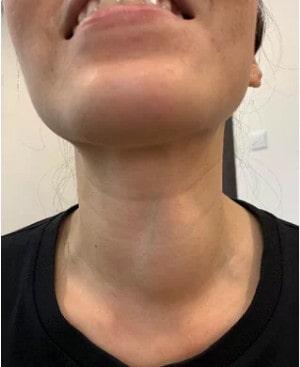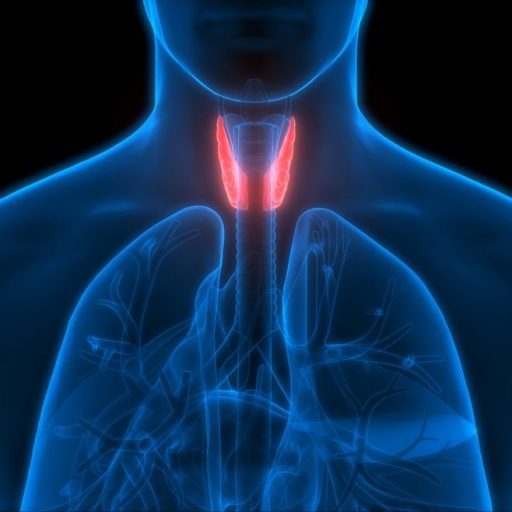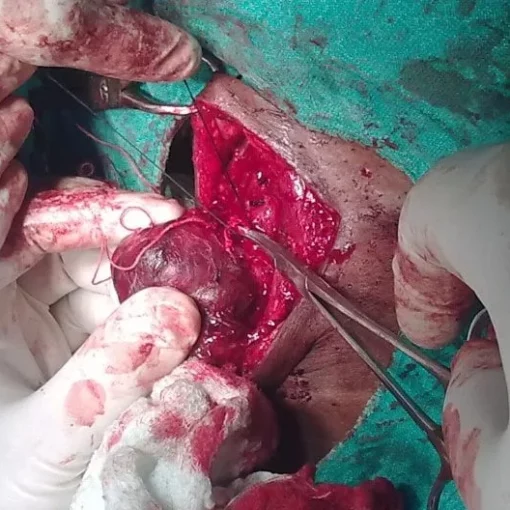Multinodular Goiter:
Its Causes, Treatment, Complications and More
How Common Is Goiter?
Goiter, particularly multinodular goiter (MNG), is the most common thyroid disease globally. An estimated 1.5 billion people , or 15% of the population, have one. Fortunately, most multinodular goiters are not life-threatening and many remain undetected. Nevertheless, MNGs do increase your risk of having a toxic nodular goiter or even developing thyroid cancer. Thyroid cancer invariably requires specific medical treatments and surgery.
Multinodular Goiter MNG: A Global Perspective
Multinodular goiters are especially prevalent, or ‘endemic’, in iodine-deficient regions. In countries where the use of iodized salt is more common, MNG frequency drops to around 4 – 5% and is predominantly caused by autoimmune diseases.
Your Thyroid Gland And Multinodular Goiter
The thyroid is responsible for producing the hormones triiodothyronine (T3), and tetraiodothyronine (thyroxine or T4). It is controlled by the pituitary gland via the thyroid stimulating hormone (TSH) thyrotropin/thyrotrophin. T3 and T4 hormones in turn control a number of important body functions.
Thyroid Nodules And MNG
A normal healthy thyroid gland is uniform in texture and appearance. However, this butterfly-shaped gland located just below the voice box is very prone to developing nodules.
Notably women, people over 55, and those in iodine-lacking areas have the highest prevalence of thyroid nodules. In fact, around 50% of the population have at least one nodule. Most though are not aware of it, usually because the nodules are not clinically apparent.

Are Thyroid Nodules Dangerous?
Ninety-five percent of nodules are benign. They present as abnormal tissue enlargements on or within the gland itself and can be fluid-filled or solid.
Nodule size varies, with some of the smallest measuring just a few millimeters (1/16th inch) whilst the largest ones can be around 5 – 6 centimeters (1 ½ – 2 ½ inches). The average is between 1.5 to 2 centimeters (½ – ¾ inch).
Nodular goiter may go unnoticed: small nodules located deep within the thyroid’s tissue will often go unnoticed during a physical exam. Larger and/or surface ones can result in ‘nodular goiter’ and/or an enlarged thyroid gland.
Goiter Overview
 Definition Of Goiter
Definition Of Goiter
The official goiter definition is a ‘swollen or enlarged thyroid gland’ (TG). It can present as either an overall swelling of your thyroid gland or an enlargement caused by nodular thyroid cell growth.
Why Do People Get Multinodular Goiters And Goiters?
Why people develop multinodular goiters is unclear. Typically however it’s usually triggered when thyroid cells adversely impact hormone (TH) production in some way.
Types Of Goitre/Goiter
Diffuse Or Simple Goiter
A diffuse or simple goiter is a uniformly smooth, consistent enlargement of the entire thyroid gland.
Nodular Goiter
A nodular goiter is an enlargement of the thyroid gland caused by a nodule or nodules. It may be a single large nodule or multiple nodules located within or on the thyroid’s surface.
Multinodular Goiter
Multinodular goiter is an enlargement of the thyroid gland caused by multiple enlarged nodules. Goiters are further classified by functionality:
- Toxic: produces too much hormone,
- Non-toxic: produces hormone normally (euthyroidism),
- Endemic: widespread amongst a population in a particular region,
- Colloid: benign goiter that contains colloid material.
Stringing these definitions together produces:
- Toxic multinodular goiter: has several autonomously functioning thyroid nodules (AFTN) (Plummer’s adenoma) that produce hormone. Some nodules in the same goiter may be non-toxic.
- Nontoxic multinodular goiter: has multiple nodules, none of which affect the thyroid’s hormone production.
- Toxic nodular goiter or toxic adenoma: has one AFTN that produces hormone.
- Diffuse toxic goiter: the entire gland is enlarged and produces too much thyroid hormone.
- Nontoxic goiter (nodular or diffuse): produces normal amounts of hormone despite being enlarged. Also called a sporadic goiter.
- Endemic goiter: usually refers to goiters, like those caused by iodine deficiency, that are ‘endemic’ amongst a particular population,
- Retrosternal/substernal goiter: usually starts as a multinodular goiter and eventually grows down into the upper chest cavity.
Do Goiters Go Away On Their Own?
If you have been diagnosed with a swelling in your neck you should see your physician as it has many potential causes. Whilst a simple goiter can be temporary and disappear quickly without any treatment, other types of goiter may affect the thyroid’s function.

A goiter can be simply a swollen-looking thyroid gland or it may have a lumpy appearance caused by visible nodules on and within its tissues.
Most goiters, particularly most multinodular goiters, are associated with thyroid hormone production.
These goiters typically don’t require treatment once diagnosed unless they become hyperthyroidic.
What Does A Goiter Look Like?
A goiter can be simply a swollen-looking thyroid gland or it may have a lumpy appearance caused by visible nodules on and within its tissues.
Underlying Risk Factors For Goiter
Common causes of goiter are cancer, large or multiple nodules, and insufficient iodine.
Globally the most common underlying risk factor for goiter development is iodine deficiency, particularly in regions where dietary iodine intake is inadequate. Iodine is required for TH production.
Not getting enough iodine can cause the thyroid to expand to try and maximize iodine absorption and produce sufficient hormone.
 Other established goiter formation risk factors include:
Other established goiter formation risk factors include:
- Genetic factors
- Age
- Gender
- Autoimmune disorders (Grave’s and Hashimoto’s disease)
-
- Graves’ disease. This is an autoimmune disorder in which the immune system attacks the gland, causing it to expand and produce more hormone (hyperthyroidic).
- Hashimoto’s disease is an autoimmune disorder in which the gland either becomes inflamed or increases in size to produce more hormone. A major trigger for developing hypothyroidism, this type of goiter often repairs itself with time or treatment with hormone.
Medical history of TG issues like:
- Underactive thyroid (hypothyroidism): doesn’t produce enough hormone and enlarges as a compensatory measure.
- Overactive thyroid (hyperthyroidism): excess production of hormone.
- Subclinical hyperthyroidism: TSH levels are low but thyroid hormone levels are normal.
- Thyroid cancer: cancerous growths may cause the gland to enlarge.
Secondary Factors
Secondary factors that can abnormally stimulate gland cell growth and/or function include:
- Smoking
- Some types of drugs
- Elevated TSH
- Stress, and
- Various other thyroid stimulating factors such as epidermal growth factors.
Symptoms Of Multinodular Goiters And Large Goiters
Multinodular goiters, particularly a small goiter or mild goiter, usually don’t cause any noticeable symptoms apart from perhaps a swelling in the base of the neck. Larger goiters though may cause symptoms if they expand and compress adjoining structures.
Symptoms of multinodular goiter may include:
- Difficulty breathing
- Pain in the lower neck or around the ears
- Continual feeling of having something stuck in your throat
- Difficulty swallowing
- Hoarse voice
A toxic multinodular goiter producing too much thyroid hormone can also cause symptoms of hyperthyroidism.
Diagnosing Multinodular Goiter
 Multinodular goiters are usually picked up by a routine physical exam. The physician looks for enlargements in the gland and checks the shape and size of any nodules present. If nodules are found, one or more of the following tests may be conducted:
Multinodular goiters are usually picked up by a routine physical exam. The physician looks for enlargements in the gland and checks the shape and size of any nodules present. If nodules are found, one or more of the following tests may be conducted:
- Thyroid function test
- Thyroid ultrasound
- Biopsy with fine-needle aspiration (FNA)
- Thyroid scan
Multinodular Goiter Treatments
Treating multinodular goiter depends on how big it is, and whether it’s toxic. Typical treatments include:
- Wait and watch (non-toxic goiters)
- Medications to treat hyperthyroidism symptoms
- Thyroid surgery/thyroidectomy
Complications Associated With Multinodular Goiters/Very Large Goiter
Very large goiters and MNGs can cause breathing and swallowing issues as they compress the windpipe and esophagus. They can also cause deep vein thrombosis in the area around the thyroid if they compress blood flow.
Do You Have An MNG Or Symptoms Of Hyperthyroidism?
Multinodular goiter is a common condition. Therefore, it’s vital to stay informed. If you worry about your thyroid health, take action. You might ask, “Is my thyroid swollen?” In this case, consult a doctor. He or she can conduct thyroid function tests. Likewise, they can perform a physical examination. This could reveal issues such as large nodules. Undoubtedly, large goiters require attention. Even more so if they are extremely large. So, always get them checked.
For more information about MNG, check the American Thyroid Association.







